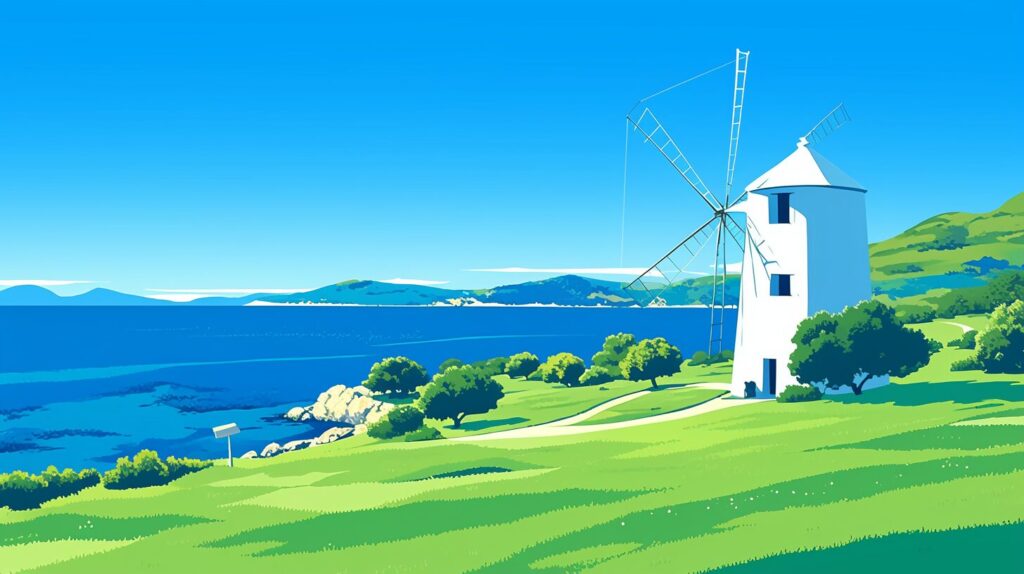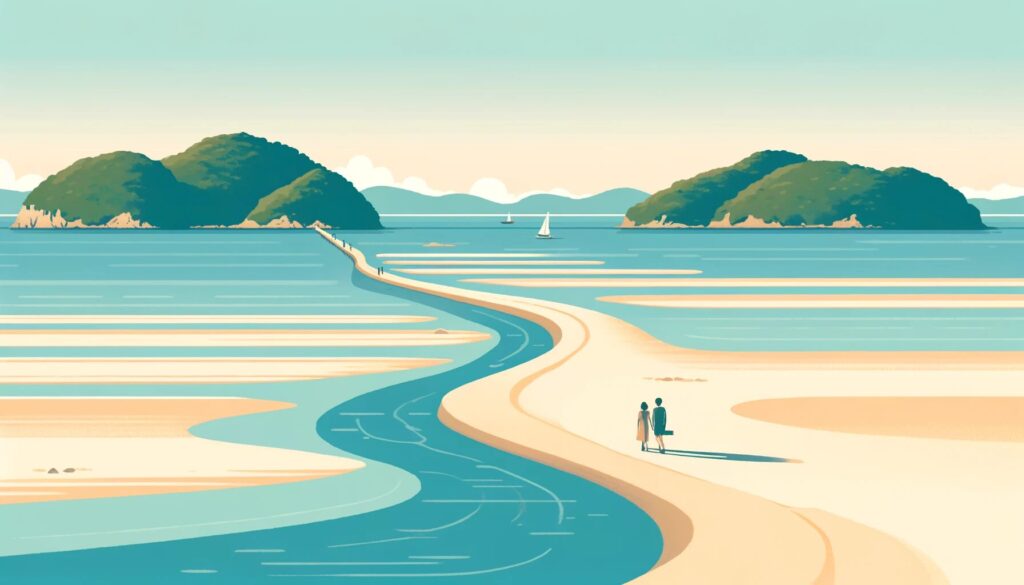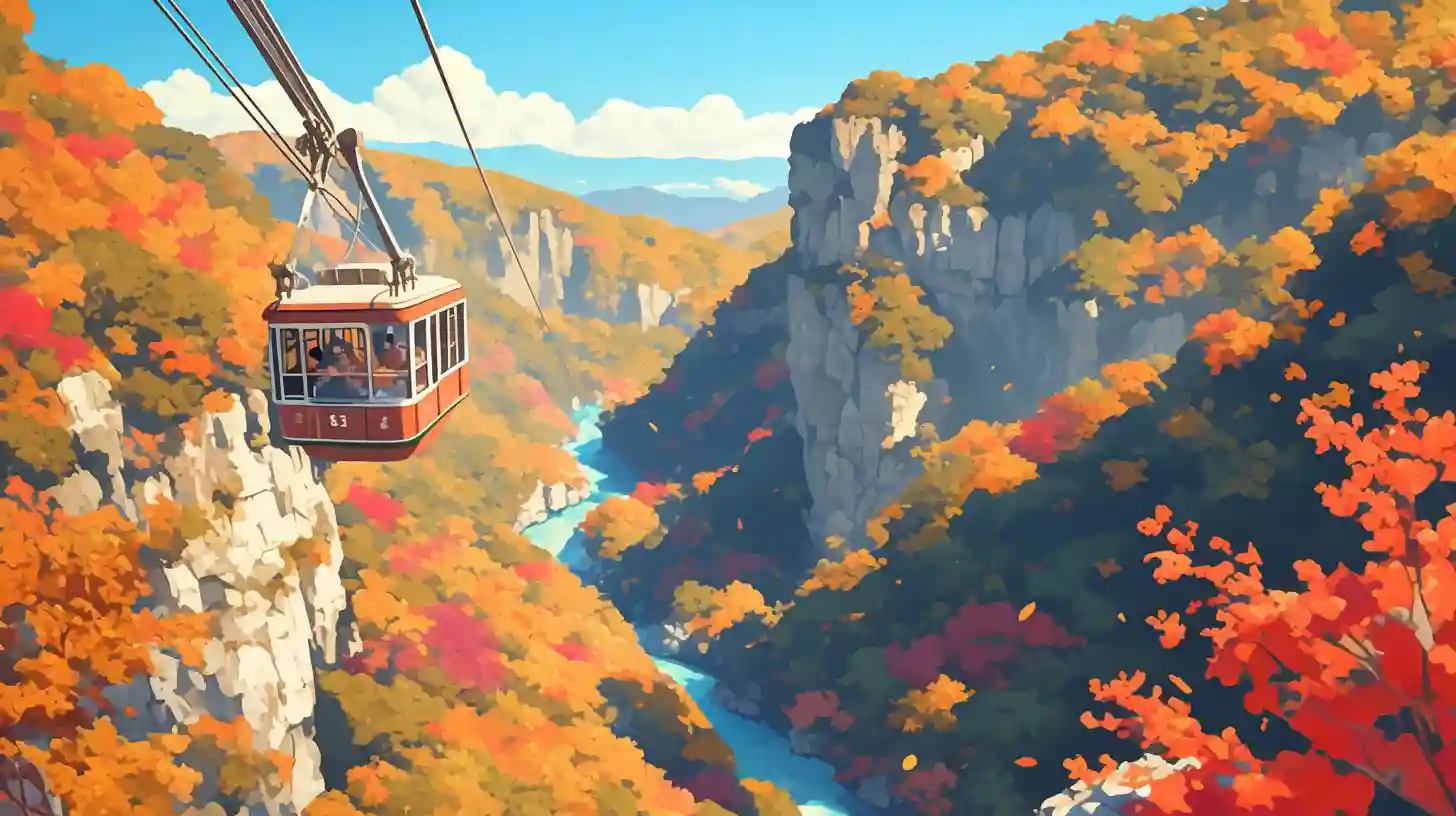小豆島を英語で説明・紹介するための基本情報と、英会話に役立つ表現をシンプルでわかりやすい英語で紹介します。
英会話ダイアローグ・概要・10の質問を通して、小豆島に関する英語表現を学びます。
英語
英会話ダイアローグを読む前に知っておくと良い前提知識と情報です。
- 小豆島の基本情報
- 香川県に属する島で、高松市などから船で約1時間
- 温暖で雨が少ない瀬戸内海式気候
- 小豆島の主な見どころ
- 寒霞渓: 日本三大渓谷美の一つで、特に秋の紅葉が美しい、ロープウェイで上空から景色を楽しめる
- エンジェルロード: 潮の満ち引きで現れる砂州で、恋人たちの聖地として人気
- オリーブ公園: 日本初のオリーブ栽培地、オリーブ畑やギリシャ風車が特徴的で、写真スポットとしても有名
- 二十四の瞳映画村: 小説『二十四の瞳』の映画セットを保存した観光地、昭和時代の雰囲気を体感できる
- 中山千枚田:棚田(段々になった水田)の景勝地
- 小豆島の特産品
- オリーブ製品: 日本初のオリーブ栽培地、オリーブオイル、オリーブアイス、化粧品などが有名
- 醤油: 江戸時代から伝統的な製法で作られる醤油、島内には見学可能な醤油蔵もある
- 手延べそうめん: 職人技が光るそうめんで、全国的にも高評価
- 小豆島の体験型アクティビティ
- オリーブ摘み体験: 秋にはオリーブ収穫を楽しめる
- そうめん作り体験: 地元の伝統を学びながら、手延べそうめんを自分で作れる
- ハイキング: 寒霞渓や中山千枚田など、自然を満喫できるコースが豊富
- アクセスと滞在のポイント
- アクセス: 高松港(香川)、新岡山港(岡山)、姫路港(兵庫)などからフェリーで約1時間
- 滞在の目安: 主な観光地を回るなら1~2日、体験型アクティビティも含めるなら3日程度
- 小豆島の文化とイベント
- 歴史: 『古事記』にも登場し、古代から人々が住んでいた歴史ある島
- 瀬戸内国際芸術祭: 現代アートが点在するイベントで、芸術と自然を融合した魅力を体験できる
2人が小豆島について話しています。
寒霞渓やエンジェルロード、オリーブ園、二十四の瞳映画村など小豆島の見どころ、アクティビティ、特産品のオリーブと醤油などを話題にしています。
会話 / dialogue

Hey Key, have you ever heard of Shodoshima? I was reading about it the other day, and it sounds amazing.

Of course! Shodoshima is one of the most beautiful islands in the Seto Inland Sea. Why are you interested in it?

Well, I love nature, and I heard it has some incredible spots like Kankakei Gorge. What’s it like?

Oh, Kankakei is breathtaking. It’s a gorge with steep cliffs and stunning views, especially in autumn when the leaves turn red and orange. You can even take a ropeway to enjoy the scenery from above.

That sounds incredible. I also read about Angel Road. Is that the sandbar that appears at low tide?

Exactly! It connects the main island to small islets nearby. People call it a “Lovers’ Sanctuary.” Couples love walking hand-in-hand there, believing it brings good luck.

I’d like to see that. I also read that Shodoshima is famous for olives. Is it true they were the first in Japan to grow olives?

Yes, that’s right. Olive farming started there in 1908, and now the island is known as the “Olive Island.” You can visit the Olive Park, where they have olive groves and even a Greek-style windmill.

That’s so unique. Can you try anything made from olives there?

Definitely! You can sample olive oil, olive ice cream, and even cosmetics made from olives. They’re really proud of their olive products.

I also saw that Shodoshima has a rich history with soy sauce. Do they still make it traditionally?

Yes, many soy sauce breweries on the island still use traditional wooden barrels. You can tour the factories, taste soy sauce, and buy unique flavors. It’s fascinating to see how they’ve preserved this craft for centuries.

Sounds like a lot to do already. But are there other activities or places to explore?

Oh, plenty! You can visit the Twenty-Four Eyes Movie Village. It’s like stepping back in time to an old Japanese village. And for more adventure, you can hike through the terraced rice fields at Nakayama Senmaida.

That’s the terraced rice fields, right? I’d love to take photos there. It must be so peaceful.

It really is. Plus, Shodoshima hosts the Setouchi Triennale art festival, so you can find unique art installations all over the island.

Art, history, nature, and food—it seems like Shodoshima has everything. How do you get there?

It’s pretty easy. You can take a ferry from Takamatsu, Okayama, or Himeji. The ride is about an hour or so, depending on where you depart.

That’s convenient. Do you think a weekend is enough to explore?

It’s possible, but if you want to experience everything, like olive picking, somen-making, and hiking, I’d recommend staying three days.

Good idea. I think I’ll plan a trip soon. Thanks for the info, Key!

No problem, Mack. Let me know if you need more tips! You’ll love Shodoshima.
概要 / Overview
「小豆島」について、理解を深めるための「英語での概要」です。
小豆島

Location and Climate
Shodoshima is a small island located in the Seto Inland Sea, northeast of Kagawa Prefecture, Japan. It is the 19th largest island in the country, with an area of about 153.30 square kilometers and a population of around 28,000. The island enjoys a mild Seto Inland Sea climate, making it a great place to visit all year round. Summers are warm, and winters are mild, which is perfect for outdoor activities.
Natural Attractions
Shodoshima is known for its beautiful landscapes. One of its most famous spots is Kankakei Gorge, a stunning valley with steep cliffs and colorful views, especially during the autumn season. Visitors can take a ropeway to see the scenery from above. Another unique attraction is Angel Road, a sandbar that appears twice a day at low tide. It connects the main island to small islets nearby. People call it a “Lovers’ Sanctuary,” and many couples visit it to walk hand-in-hand.
Cultural and Historical Significance
Shodoshima has a rich history and culture. It was the first place in Japan to grow olives, starting in 1908. Today, it is called the “Olive Island,” and visitors can enjoy olive groves, olive oil, and other olive-based products at the Shodoshima Olive Park. The island is also famous for its traditional soy sauce production, which began during the Edo period. Visitors can tour soy sauce breweries and learn about the traditional wooden-barrel methods still used today.
Local Specialties
Shodoshima offers delicious local specialties. The island is well-known for its olive oil, olive ice cream, and hand-stretched somen noodles. These noodles are made by skilled artisans and are considered some of the best in Japan. Soy sauce and tsukudani (soy sauce-preserved food) are also popular souvenirs.
Activities and Access
Visitors can enjoy various activities on Shodoshima, such as olive picking, somen-making workshops, hiking through the beautiful terraced rice fields of Nakayama Senmaida, or exploring art installations from the Setouchi Triennale. Shodoshima is easily accessible by ferry from Takamatsu, Okayama, or Himeji, with ferry rides taking about an hour.
Conclusion
Shodoshima is a unique destination that offers something for everyone—stunning nature, rich history, delicious food, and fun activities. Whether you’re interested in exploring, learning, or relaxing, this beautiful island is a perfect getaway in Japan.
10の質問 / 10 questions
「小豆島」について、理解を深めるための「英語での10の質問」です。
1: What is Shodoshima?
Shodoshima is an island in Japan’s Seto Inland Sea, known for its olive cultivation and scenic beauty.
2: Where is Shodoshima located?
Shodoshima is situated northeast of Kagawa Prefecture in the Seto Inland Sea.
3: How can you reach Shodoshima?
You can reach Shodoshima by ferry from Takamatsu, Okayama, or Himeji; the journey takes about an hour.
4: What is Kankakei Gorge?
Kankakei Gorge is a famous valley on Shodoshima, known for its steep cliffs and beautiful autumn colors.
5: What is Angel Road?
Angel Road is a sandbar on Shodoshima that appears twice a day at low tide, connecting the main island to nearby islets.
6: Why is Shodoshima called “Olive Island”?
Shodoshima is called “Olive Island” because it was the first place in Japan to successfully grow olives, starting in 1908.
7: What traditional product is Shodoshima known for?
Shodoshima is known for its traditional soy sauce production, which began during the Edo period.
8: What can visitors do at Shodoshima Olive Park?
At Shodoshima Olive Park, visitors can see olive groves, a Greek-style windmill, and enjoy various olive-based products.
9: What is the significance of the novel “Twenty-Four Eyes” to Shodoshima?
The novel “Twenty-Four Eyes” is set on Shodoshima, and the island has a movie village dedicated to it.
10: What is the Shodoshima 88-temple pilgrimage?
Shodoshima has a miniature version of the Shikoku 88-temple pilgrimage, allowing visitors to visit 88 temples on the island.

和訳付
会話 / dialogue

Hey Key, have you ever heard of Shodoshima? I was reading about it the other day, and it sounds amazing.
キー、小豆島って知ってる?この間読んでみたんだけど、すごく面白そうなところだよ。

Of course! Shodoshima is one of the most beautiful islands in the Seto Inland Sea. Why are you interested in it?
もちろん!小豆島は瀬戸内海で最も美しい島の一つだよ。どうして興味を持ったの?

Well, I love nature, and I heard it has some incredible spots like Kankakei Gorge. What’s it like?
自然が大好きなんだ。それで、寒霞渓っていうすごいスポットがあるって聞いたんだけど、どんな感じ?

Oh, Kankakei is breathtaking. It’s a gorge with steep cliffs and stunning views, especially in autumn when the leaves turn red and orange. You can even take a ropeway to enjoy the scenery from above.
寒霞渓は本当に息をのむほど美しいよ。切り立った崖と素晴らしい景色が楽しめるんだ。特に秋になると、紅葉で真っ赤やオレンジに染まる。ロープウェイに乗れば上から景色を楽しめるよ。

That sounds incredible. I also read about Angel Road. Is that the sandbar that appears at low tide?
それはすごいね。他にもエンジェルロードって読んだけど、あれは潮が引いたときに現れる砂州のこと?

Exactly! It connects the main island to small islets nearby. People call it a “Lovers’ Sanctuary.” Couples love walking hand-in-hand there, believing it brings good luck.
そうだよ!本島と近くの小島をつなぐ砂州のことだね。「恋人の聖地」とも呼ばれていて、カップルが手をつないで歩くと幸運を呼ぶって言われてるんだ。

I’d like to see that. I also read that Shodoshima is famous for olives. Is it true they were the first in Japan to grow olives?
それをぜひ見てみたいな。それから、小豆島はオリーブで有名だって読んだんだけど、日本で最初にオリーブを育てたのは本当?

Yes, that’s right. Olive farming started there in 1908, and now the island is known as the “Olive Island.” You can visit the Olive Park, where they have olive groves and even a Greek-style windmill.
そうだよ。1908年にオリーブの栽培が始まって、今では「オリーブの島」として知られてるんだ。オリーブ公園ではオリーブ畑やギリシャ風の風車も見られるよ。

That’s so unique. Can you try anything made from olives there?
それはユニークだね。オリーブを使ったものを試したりできるの?

Definitely! You can sample olive oil, olive ice cream, and even cosmetics made from olives. They’re really proud of their olive products.
もちろん!オリーブオイルやオリーブアイス、さらにはオリーブを使った化粧品まで試せるよ。オリーブ製品は島の誇りなんだ。

I also saw that Shodoshima has a rich history with soy sauce. Do they still make it traditionally?
あと、小豆島には醤油の豊かな歴史があるって読んだんだけど、今でも伝統的な作り方をしてるの?

Yes, many soy sauce breweries on the island still use traditional wooden barrels. You can tour the factories, taste soy sauce, and buy unique flavors. It’s fascinating to see how they’ve preserved this craft for centuries.
うん、島の多くの醤油蔵は今でも木桶を使った伝統的な製法を続けているよ。工場を見学したり、醤油を試飲したり、ユニークな味を買うこともできるんだ。この伝統を何世紀も守ってきたことには本当に感心するよ。

Sounds like a lot to do already. But are there other activities or places to explore?
それだけでも十分楽しそうだけど、他にもアクティビティや訪れるべき場所がある?

Oh, plenty! You can visit the Twenty-Four Eyes Movie Village. It’s like stepping back in time to an old Japanese village. And for more adventure, you can hike through the terraced rice fields at Nakayama Senmaida.
たくさんあるよ!例えば「二十四の瞳映画村」に行けるよ。昔の日本の村にタイムスリップしたみたいな気分になれる。それに、もう少し冒険したいなら中山千枚田の棚田をハイキングしてみて。

That’s the terraced rice fields, right? I’d love to take photos there. It must be so peaceful.
それって棚田のことだよね?写真を撮るのが楽しそうだ。きっとすごく静かで落ち着く場所なんだろうね。

It really is. Plus, Shodoshima hosts the Setouchi Triennale art festival, so you can find unique art installations all over the island.
本当にそうだよ。それに、小豆島では瀬戸内国際芸術祭も開催されていて、島中でユニークなアート作品に出会えるよ。

Art, history, nature, and food—it seems like Shodoshima has everything. How do you get there?
アート、歴史、自然、グルメ…小豆島って何でも揃ってるみたいだね。どうやって行くの?

It’s pretty easy. You can take a ferry from Takamatsu, Okayama, or Himeji. The ride is about an hour or so, depending on where you depart.
簡単だよ。高松、岡山、姫路からフェリーが出てるよ。乗る場所によるけど、だいたい1時間くらいで着くよ。

That’s convenient. Do you think a weekend is enough to explore?
便利だね。週末だけで十分楽しめると思う?

It’s possible, but if you want to experience everything, like olive picking, somen-making, and hiking, I’d recommend staying three days.
可能だと思うけど、オリーブ摘みやそうめん作り、ハイキングも全部楽しみたいなら、3日くらい滞在するのがおすすめかな。

Good idea. I think I’ll plan a trip soon. Thanks for the info, Key!
いい考えだね。近いうちに旅行を計画しようかな。教えてくれてありがとう、キー!

No problem, Mack. Let me know if you need more tips! You’ll love Shodoshima.
どういたしまして、マック。他にアドバイスが必要なら教えてね!絶対に小豆島を気に入ると思うよ。
概要 / Overview
小豆島

Location and Climate
Shodoshima is a small island located in the Seto Inland Sea, northeast of Kagawa Prefecture, Japan. It is the 19th largest island in the country, with an area of about 153.30 square kilometers and a population of around 28,000. The island enjoys a mild Seto Inland Sea climate, making it a great place to visit all year round. Summers are warm, and winters are mild, which is perfect for outdoor activities.
小豆島は、日本の香川県北東部にある瀬戸内海に位置する小さな島です。日本で19番目に大きい島で、面積は約153.30平方キロメートル、人口は約28,000人です。瀬戸内海式気候の温暖な気候に恵まれており、一年を通じて訪れるのに最適な場所です。夏は暖かく、冬は穏やかで、アウトドア活動に最適です。
Natural Attractions
Shodoshima is known for its beautiful landscapes. One of its most famous spots is Kankakei Gorge, a stunning valley with steep cliffs and colorful views, especially during the autumn season. Visitors can take a ropeway to see the scenery from above. Another unique attraction is Angel Road, a sandbar that appears twice a day at low tide. It connects the main island to small islets nearby. People call it a “Lovers’ Sanctuary,” and many couples visit it to walk hand-in-hand.
小豆島は美しい景色で知られています。特に有名なのは寒霞渓で、切り立った崖と秋に色鮮やかになる風景が特徴的な渓谷です。訪問者はロープウェイに乗って、上から景色を楽しむことができます。もう一つのユニークな名所はエンジェルロードで、潮が引いた時に1日2回現れる砂州です。本島と近くの小島を結び、「恋人の聖地」として知られ、多くのカップルが手をつないで歩きに訪れます。
Cultural and Historical Significance
Shodoshima has a rich history and culture. It was the first place in Japan to grow olives, starting in 1908. Today, it is called the “Olive Island,” and visitors can enjoy olive groves, olive oil, and other olive-based products at the Shodoshima Olive Park. The island is also famous for its traditional soy sauce production, which began during the Edo period. Visitors can tour soy sauce breweries and learn about the traditional wooden-barrel methods still used today.
小豆島には豊かな歴史と文化があります。1908年に日本で初めてオリーブ栽培が始まりました。現在では「オリーブの島」として知られ、オリーブ公園ではオリーブ畑やオリーブオイル、オリーブを使った商品を楽しむことができます。また、江戸時代から始まった伝統的な醤油作りでも有名です。訪問者は醤油蔵を見学し、今でも使われている木桶を使った製法について学ぶことができます。
Local Specialties
Shodoshima offers delicious local specialties. The island is well-known for its olive oil, olive ice cream, and hand-stretched somen noodles. These noodles are made by skilled artisans and are considered some of the best in Japan. Soy sauce and tsukudani (soy sauce-preserved food) are also popular souvenirs.
小豆島には美味しい地元の特産品があります。オリーブオイル、オリーブアイス、手延べそうめんが特に有名です。手延べそうめんは熟練した職人によって作られ、日本でも最高品質の一つとされています。醤油や佃煮(醤油で味付けした保存食品)も人気のお土産です。
Activities and Access
Visitors can enjoy various activities on Shodoshima, such as olive picking, somen-making workshops, hiking through the beautiful terraced rice fields of Nakayama Senmaida, or exploring art installations from the Setouchi Triennale. Shodoshima is easily accessible by ferry from Takamatsu, Okayama, or Himeji, with ferry rides taking about an hour.
小豆島では、オリーブ摘みやそうめん作りのワークショップ、中山千枚田の美しい棚田をハイキングしたり、瀬戸内国際芸術祭のアート作品を探索したりと、さまざまなアクティビティを楽しめます。小豆島へのアクセスは簡単で、高松、岡山、姫路からフェリーで約1時間で到着します。
Conclusion
Shodoshima is a unique destination that offers something for everyone—stunning nature, rich history, delicious food, and fun activities. Whether you’re interested in exploring, learning, or relaxing, this beautiful island is a perfect getaway in Japan.
小豆島は、誰にとっても魅力的なユニークな目的地です。美しい自然、豊かな歴史、美味しい食べ物、楽しいアクティビティが揃っています。探索、学び、リラックスのいずれを目的にしても、この美しい島は日本の理想的な旅行先です。
10の質問 / 10 questions
1: What is Shodoshima?
小豆島とは何ですか?
Shodoshima is an island in Japan’s Seto Inland Sea, known for its olive cultivation, scenic beauty, and traditional soy sauce production.
小豆島は日本の瀬戸内海にある島で、オリーブの栽培、美しい景観、そして伝統的な醤油作りで知られています。
2: Where is Shodoshima located?
小豆島はどこにありますか?
Shodoshima is located northeast of Kagawa Prefecture in the Seto Inland Sea, between Japan’s main islands of Honshu and Shikoku.
小豆島は香川県の北東部、瀬戸内海に位置しており、本州と四国の間にあります。
3: How can you reach Shodoshima?
小豆島へはどうやって行けますか?
You can take a ferry from Takamatsu, Okayama, or Himeji. The ferry ride takes about 60 to 100 minutes, depending on the departure port.
高松、岡山、姫路からフェリーで行くことができます。フェリーの所要時間は出発港によりますが、約60~100分です。
4: What is Kankakei Gorge?
寒霞渓とは何ですか?
Kankakei Gorge is a famous valley on Shodoshima, known for its steep cliffs and beautiful autumn leaves. It is one of Japan’s three most beautiful gorges.
寒霞渓は小豆島にある有名な渓谷で、切り立った崖と美しい秋の紅葉で知られています。日本三大渓谷美の一つです。
5: What is Angel Road?
エンジェルロードとは何ですか?
Angel Road is a sandbar that appears at low tide, connecting Shodoshima’s main island to nearby islets. It is popular among couples as a “Lovers’ Sanctuary.”
エンジェルロードは潮が引いた時に現れる砂州で、小豆島本島と近くの小島をつなぎます。「恋人の聖地」としてカップルに人気です。
6: Why is Shodoshima called “Olive Island”?
小豆島はなぜ「オリーブの島」と呼ばれるのですか?
Shodoshima was the first place in Japan to successfully grow olives in 1908, and now it is famous for its olive products and Olive Park.
小豆島は1908年に日本で初めてオリーブ栽培に成功した場所で、現在はオリーブ製品とオリーブ公園で有名です。
7: What is Shodoshima’s traditional product?
小豆島の伝統的な特産品は何ですか?
Shodoshima is known for its soy sauce, which has been made traditionally in wooden barrels since the Edo period.
小豆島は醤油で有名で、江戸時代から木桶を使った伝統的な製法で作られています。
8: What can you do at Shodoshima Olive Park?
小豆島オリーブ公園では何ができますか?
At Olive Park, you can explore olive groves, take photos with a Greek-style windmill, and taste olive oil or olive ice cream.
オリーブ公園ではオリーブ畑を散策したり、ギリシャ風の風車で写真を撮ったり、オリーブオイルやオリーブアイスを味わえます。
9: What is the connection between “Twenty-Four Eyes” and Shodoshima?
『二十四の瞳』と小豆島の関係は何ですか?
The novel Twenty-Four Eyes is set on Shodoshima. There is a movie village on the island that preserves the film set.
小説『二十四の瞳』は小豆島を舞台にしています。島には映画のセットを保存した映画村があります。
10: What is the Shodoshima 88-temple pilgrimage?
小豆島八十八ヶ所巡りとは何ですか?
The Shodoshima 88-temple pilgrimage is a smaller version of the famous Shikoku pilgrimage. It allows visitors to visit 88 temples on the island.
小豆島八十八ヶ所巡りは、有名な四国巡礼の小規模版で、島内の88の寺院を巡ることができます。

words & phrases
英会話ダイアローグと関連情報に出てきた単語・フレーズです(例文は各3つ)。

gorge: 名詞
意味: 深い谷、峡谷。A deep, narrow valley with steep sides, often with a stream or river running through it.
(小豆島の「寒霞渓」は、切り立った崖に囲まれた美しい峡谷で使用)
例文:
- The hikers admired the stunning views of the gorge.
「ハイカーたちは峡谷の素晴らしい景色に見とれました。」 - The river carved a deep gorge over thousands of years.
「川は何千年もの間に深い峡谷を削り出しました。」 - Many tourists visit the gorge to see the autumn leaves.
「多くの観光客が紅葉を見るために峡谷を訪れます。」
sandbar: 名詞
意味: 砂州、砂堆。A raised area of sand in a river or ocean, often visible at low tide.
(小豆島の「エンジェルロード」は、潮が引いたときに現れる砂州で使用)
例文:
- At low tide, the sandbar connects the island to the shore.
「潮が引くと、砂州が島と陸地をつなぎます。」 - The children played on the sandbar during their beach trip.
「子どもたちはビーチ旅行中に砂州で遊びました。」 - A boat got stuck on the sandbar in the shallow water.
「ボートが浅瀬の砂州に乗り上げました。」
islet: 名詞
意味: 小島。A very small island, often uninhabited.
(エンジェルロードの砂州が近くの小島(islets)とつながるときに)
例文:
- The islet was surrounded by crystal-clear water.
「小島は透き通った水に囲まれていました。」 - The fisherman rested on a tiny islet in the middle of the lake.
「漁師は湖の真ん中にある小さな島で休憩しました。」 - Several islets dot the coast near the main island.
「本島の近くの沿岸にはいくつかの小島が点在しています。」
grove: 名詞
意味: 小さな木立、果樹園。A small group of trees, often planted for fruit or shade.
(小豆島のオリーブ公園の「オリーブ畑」や木立に関連して使用)
例文:
- They walked through the olive grove, admiring the trees.
「彼らはオリーブ畑を歩きながら木々を眺めました。」 - The orange grove was full of ripe fruit.
「オレンジの果樹園は熟した果実でいっぱいでした。」 - A grove of pine trees provided shade on the hot day.
「松の木立が暑い日に日陰を作ってくれました。」
windmill: 名詞
意味: 風車。A structure with blades that are turned by the wind, often used for grinding grain or generating power.
(小豆島オリーブ公園のギリシャ風の風車について言及するときに使用)
例文:
- The windmill at the Olive Park is a popular photo spot.
「オリーブ公園の風車は人気の写真スポットです。」 - Traditional windmills were used to grind wheat into flour.
「伝統的な風車は小麦を粉にするために使われていました。」 - The blades of the windmill turned slowly in the breeze.
「風車の羽根はそよ風の中でゆっくり回っていました。」
